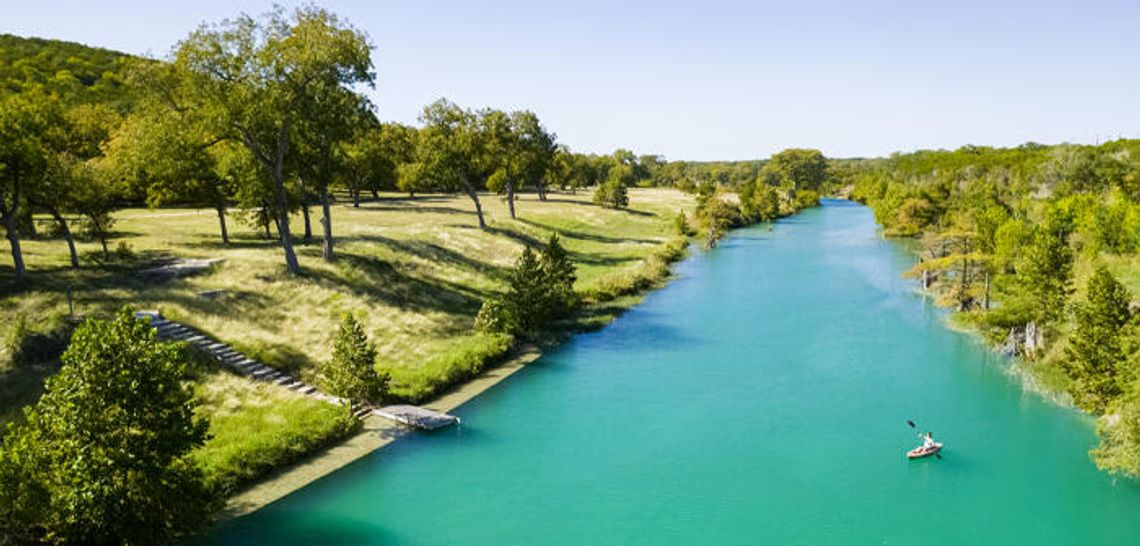Sometimes the easiest way to enjoy Central Texas’ cool spring-fed rivers and pools is slowly, a toe at a time.
The same can be true of shepherding the future of the land surrounding that cool water. Last week, Hays County stuck its first toe in by voting to pursue a plan, partnering with the Nature Conservancy, to secure for the public 530 acres of pristine Hill Country real estate.
The acreage is part of the historic El Rancho Cima, which was, for years, owned by the Sam Houston Area Council of the Boy Scouts of America. Generations of scouts camped at the “Boy Scout Camp” during the 60-year stint – hiking its hills and swimming in the Blanco River that runs through the property.
For now, the county is calling the property Sentinal Peak Preserve, named for a landmark it includes. The property that lies 18 miles west of San Marcos and straddles the Blanco River near the Devil’s Backbone also encompasses habitat for the federally-endangered golden-cheeked warbler.
The acquisition will not only open the area to the public but protect it from development – which will also have the added benefit of not increasing the severity of floods, County Judge Ruben Becerra said.
“While I’ve heard from a few people who think the new preserve, which is partly in Comal County, is ‘too far’ for easy access, it’s important to remember how this iconic land affects the rest of the county, helping to absorb heavy rain and preventing flooding in areas as far away as Precinct 1,” Becerra said.
“Our goal is to balance preserving the environmental aspects of Sentinal Peak Preserve with the public’s desire to enjoy and learn from it,” said Pct. 3 Commissioner Lon Shell, in whose precinct the property is located.
“We are working on a plan to allow limited access, preserve the warbler habitat during breeding season, and develop and maintain trails and access to the Blanco River for the public to enjoy. This project is especially exciting because it provides a rare opportunity for Hays County to create a preserve that can be used for environmental mitigation related to transportation infrastructure improvements and also conserve a natural area that will benefit the public for generations to come,” Shell said.
Laura Huffman, regional director of the Nature Conservancy, credited Shell and others on the commissioners court for their work on the project. “In partnering with Hays County to protect this property, we have a rare opportunity to simultaneously safeguard this iconic piece of our state’s history and customs while meeting conservation goals and increasing public access to nature in the fast-changing Texas Hill Country … Collaborative land conservation deals like this are the only way to protect the nature we have left in a way that benefits both people and the environment.”
“This will be a very special place for our county,” said Pct. 1 Commissioner Debbie Gonzales Ingalsbe. “Public access to this kind of natural land is important for our citizens and future generations.”
“This is a once-in-a-generation property,” Pct. 4 Commissioner Walt Smith said. “Not only is it a spectacular acquisition, but the logistics required to put this partnership together, with all its moving parts, is extraordinary.”
Although he missed the vote, Pct. 2 Commissioner Mark Jones also expressed his opinion on the project and the partnership. “Our ability to come together to combine our visions and funding make this partnership work,” he said. “Partnerships like these are realized because of outstanding leadership like that of Commissioner Shell.”
Under the terms of the deal, the county will contribute $7 million from the transportation bond monies approved by voters in 2016 – funds that were set aside specifically for environmental mitigation. The Nature Conservancy will contribute the remainder of the purchase price, roughly $6 million. The Conservancy will retain ownership until Hays County eventually buys out the Conservancy’s portion. The Conservancy will continue to have a conservation easement on the property.
Shell noted it’s not the first time the two entities have collaborated. Other examples include the creation of the Dahlstrom Preserve west of Buda.
According to the Nature Conservancy, the phenomenal growth Texas is experiencing isn’t expected to stop anytime soon. “The state’s population is expected to more than double – to 55 million people – by 2050, putting enormous pressure on our natural resources and leading to an increase in land fragmentation, one of the most acute threats to habitat and wildlife conservation today,” the organization said in a news release. “Hays County, in particular, is one of the fastest-growing and subdividing areas in not just the state but in the entire nation, making land and water protection in the region a signifiant priority for Texas conservationists.”
The Conservancy also worked with the county and the city of San Marcos to acquire Springlake Preserve on the hill above the Meadows Center for Water and the Environment.










